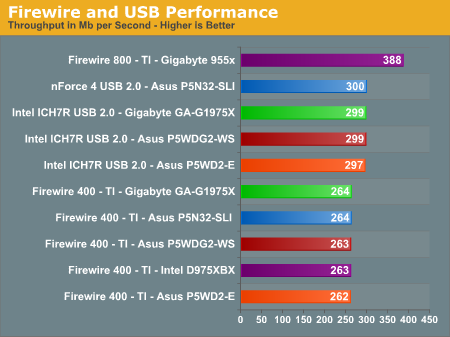Intel D975XBX: Intel brings their Bad-Axe to Market
by Gary Key on January 26, 2006 12:05 AM EST- Posted in
- Motherboards
Firewire and USB Performance
After looking at many options for Firewire and USB testing, we finally determined that an external USB 2.0, Firewire 400, and Firewire 800 hard disk would be a sensible way to look at USB and Firewire throughput.
Our first efforts at testing with an IDE or SATA drive as the "server" yielded very inconsistent results, since Windows XP sets up cache schemes to improve performance. Finally, we decided to try a RAM disk as our "server", since memory removed almost all overhead from the serving end. We also managed to turn off disk caching on the USB and Firewire side by setting up the drives for "quick disconnect" and our results were then consistent over many test runs.
We used 1GB of fast 3-2-2-8 system memory set up as a 450MB RAM disk and 550MB of system memory. Our standard file is the SPECviewPerf install file, which is 432,533,504 bytes (412.4961MB). After copying this file to our RAM disk, we measured the time for writing from the RAM disk to our external USB 2.0, Firewire 400, or Firewire 800 drive using a Windows timing program written for AnandTech by our own Jason Clark. The copy times in seconds were then converted into Megabits per second (Mb) to provide a convenient means of comparing throughput. Higher Rates therefore mean better performance in this particular test.
After looking at many options for Firewire and USB testing, we finally determined that an external USB 2.0, Firewire 400, and Firewire 800 hard disk would be a sensible way to look at USB and Firewire throughput.
Our first efforts at testing with an IDE or SATA drive as the "server" yielded very inconsistent results, since Windows XP sets up cache schemes to improve performance. Finally, we decided to try a RAM disk as our "server", since memory removed almost all overhead from the serving end. We also managed to turn off disk caching on the USB and Firewire side by setting up the drives for "quick disconnect" and our results were then consistent over many test runs.
We used 1GB of fast 3-2-2-8 system memory set up as a 450MB RAM disk and 550MB of system memory. Our standard file is the SPECviewPerf install file, which is 432,533,504 bytes (412.4961MB). After copying this file to our RAM disk, we measured the time for writing from the RAM disk to our external USB 2.0, Firewire 400, or Firewire 800 drive using a Windows timing program written for AnandTech by our own Jason Clark. The copy times in seconds were then converted into Megabits per second (Mb) to provide a convenient means of comparing throughput. Higher Rates therefore mean better performance in this particular test.











34 Comments
View All Comments
Gary Key - Saturday, February 11, 2006 - link
Actually, depending upon the device PCI-E does support single-ended transfers. I probably should have worded my statement differently.
Bozo Galora - Thursday, January 26, 2006 - link
http://img264.imageshack.us/my.php?image=intoilet3...">http://img264.imageshack.us/my.php?image=intoilet3...Zebo - Friday, January 27, 2006 - link
It's pretty sad Garys great article is'nt being read more - only 16 replies almost two days later - he can blame intel and thier non-exciting chips ATM.Gary Key - Friday, January 27, 2006 - link
I should have put "Conroe Comes to Town" in the headline. ;-) At least the board is showing the 1333 fsb setting, hint, hint. Intel's products are a little mundane at the moment but at least we have 20 replies now, anything less and I owed my dog a Big Mac.danidentity - Thursday, January 26, 2006 - link
Do you guys plan on doing a 975X motherboard roundup in the future? If so, when is it going to be ready?Gary Key - Thursday, January 26, 2006 - link
We have three more 975x boards to review. I estimate in about three weeks the roundup will be ready.
danidentity - Thursday, January 26, 2006 - link
Thanks Gary. Also, is there any word on whether 975X will support Conroe?Gary Key - Thursday, January 26, 2006 - link
We continue to ask this question. As soon as we have an answer it will be front page news. :-) This board officially supports the 1333 fsb that we will see on product launches this summer but whether they will respin the 975x or not is up in the air right now.
AGAC - Thursday, January 26, 2006 - link
The lack of performance, specialy when compared to an AMD similarly priced system should be compensated with a richer array of features. Looks like intel failed at that. Couple that with a higher energy bill, hotter/noisier computer and there you may explain why so many people now have AMD systems. For me, my last intel PC was a Pentium III. It was good for over 7 years, went from my home to my office untill a cheaply configured Sempron recently put it out of it's duties.AGAC - Thursday, January 26, 2006 - link
Can enyone tell me why? Is this "William Shakespeare inside" some spiner's new trend? And while we're talking about intel's marketing strategy what's all the hype with this viiv thang?